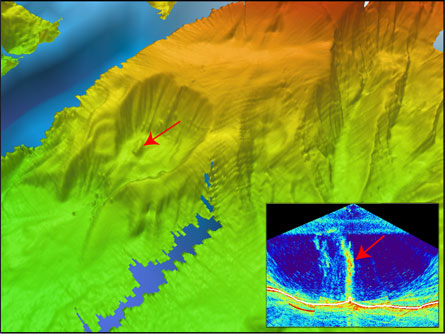An oceanographic survey has discovered a 1,400-meter-tall plume rising from the seafloor off the coast of California. Water samples taken at the site, about 32 kilometers northwest of Cape Mendocino, indicate that the feature isn’t mineral-rich water spewing from a hydrothermal vent, but researchers aren’t yet sure exactly what the feature is made of.

The mystery plume was first spotted on sonar in the dark hours of May 17, says James V. Gardner, a marine geologist at the University of New Hampshire in Durham. At the time, no one on the deck of the vessel that discovered the plume could see if it disturbed the sea surface, he and his colleagues report in the August 11 Eos. When the vessel returned to the site about two weeks later during daylight hours, scientists hovered over the spot and lowered sensors into the 1,800-meter-deep waters to take samples. During that hours-long visit, the sea looked normal — researchers saw no bubbles, unusually colored water or other signs of irregularities.
Gardner and his colleagues suggest that the plume is made up of a stream of methane bubbles coated with a veneer of methane-rich ice. That ice coating, a material called methane hydrate, is stable in deep water, where pressure is high and the water is cold. When the ice-cloaked bubbles ascend into warmer waters near the surface, the ice melts and the methane dissolves into the sea. In the coming months, further analyses of water samples taken from the plume may confirm the team’s conjecture.
Although seafloor sediments in shallow areas closer to the coast are known to harbor methane, which often bubbles free of the ocean bottom, no one has reported such plumes in waters this deep, the researchers report. The newly discovered plume appears to originate within a previously unknown, amphitheater-shaped basin on the ocean floor. This 3.6-kilometer-wide scar was probably caused by a massive undersea landslide, Gardner says.






